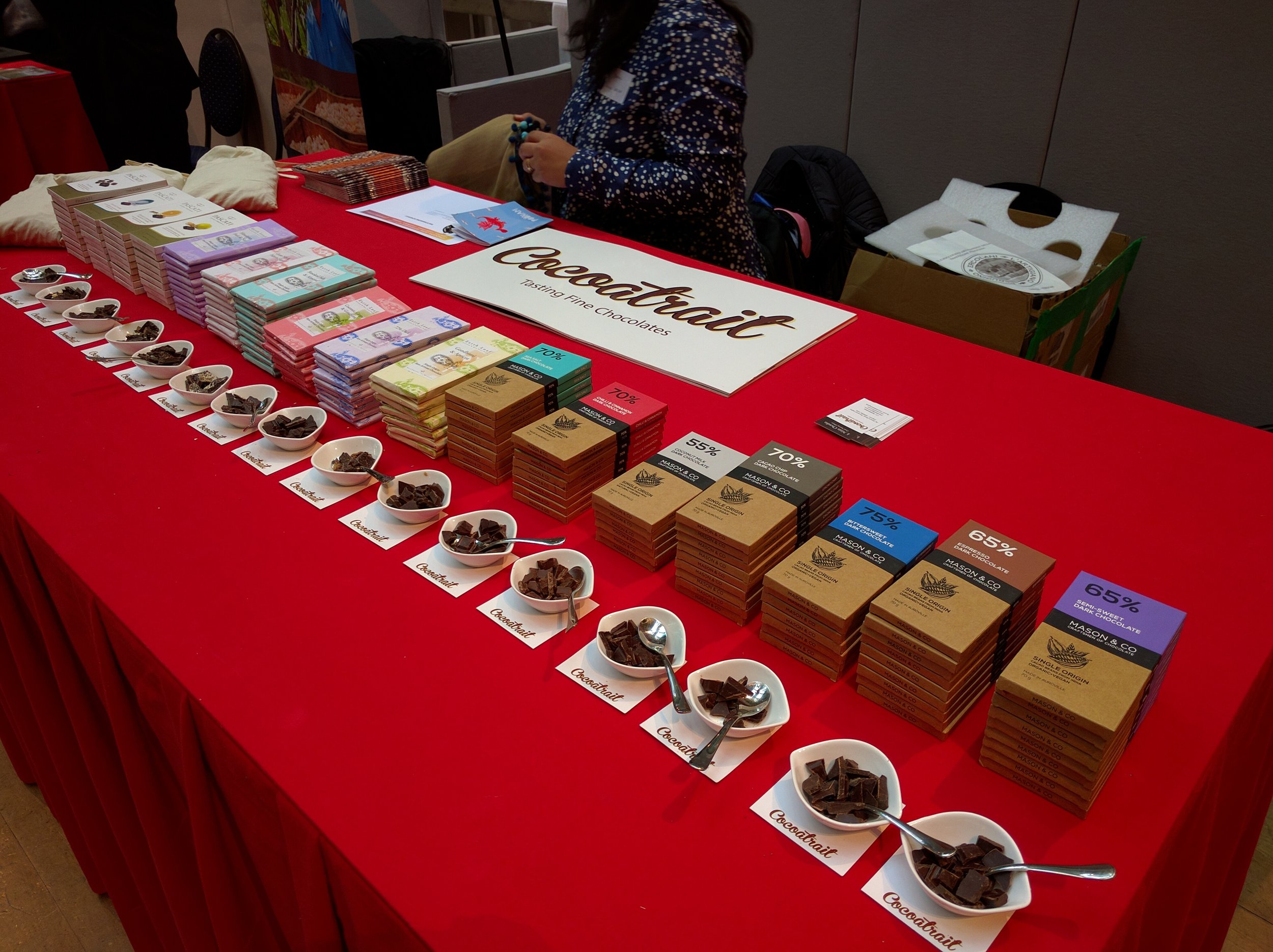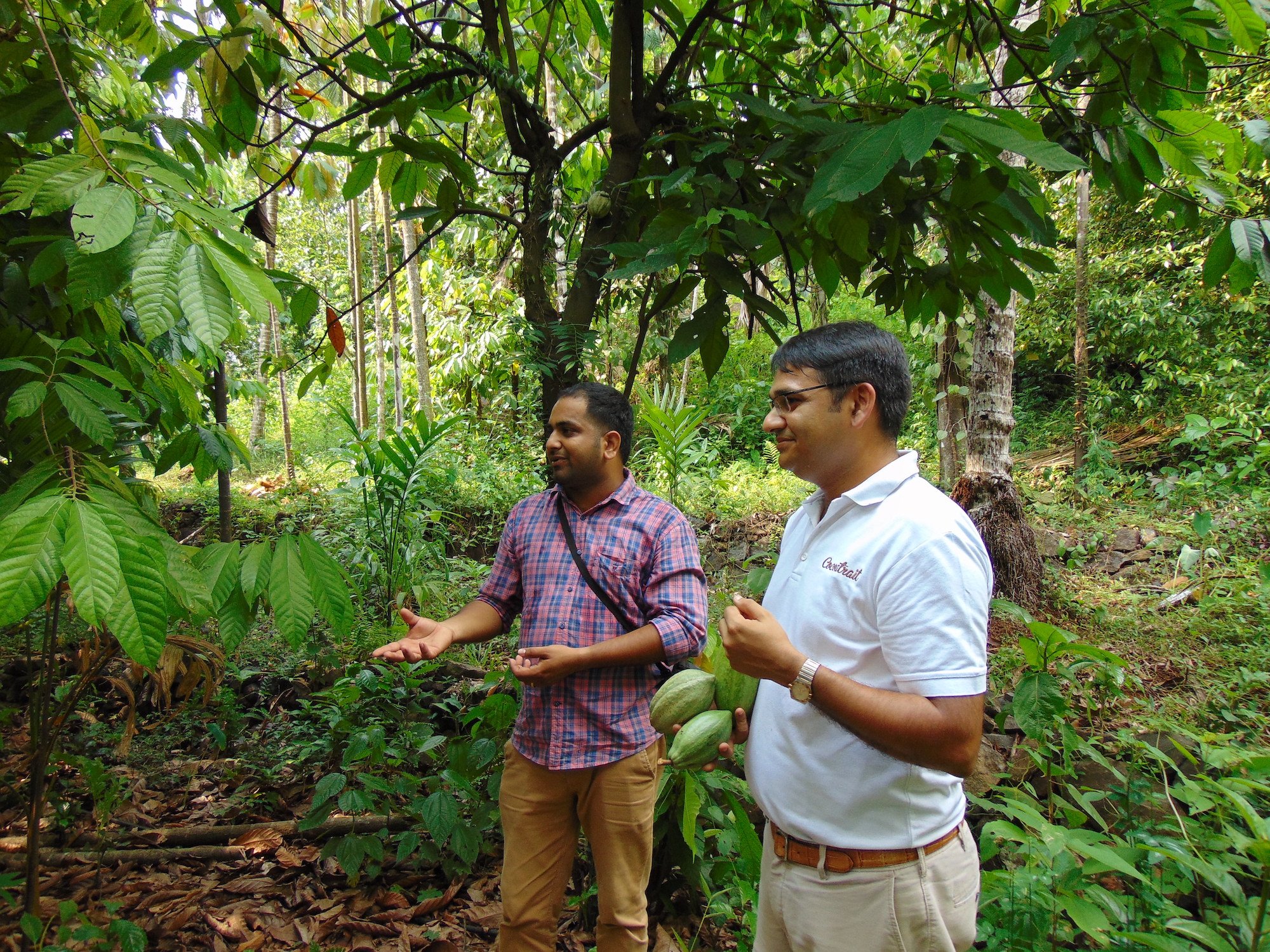The Sweet Journey of Nitin Chordia from Chocolate Taster to Sustainable Maker
Nitin during one of his tasting sessions at Godrej Natures Basket
Imagine eating wonderful chocolates and getting paid for it! A scene from the fantasy movie Charlie and the Chocolate Factory? No, this was L. Nitin Chordia’s job. Chordia’s path to becoming a chocolate expert, educator and chocolate maker began when he was setting up Nature’s Basket, a premium retail chain of the Godrej Company, India, in 2005-2006. As a consultant, he sourced and stocked products including juices, breakfast cereals, jams, pasta sauces, and gourmet chocolates. Little did he know that chocolate would become his life’s work.
Chordia evaluated 90 different brands of chocolates from across the world. Samples of wonderful chocolates arrived daily, overflowing his office, compelling him to keep the AC running continuously to store them. “I maneuvered through chocolate packages to reach my seat”, laughs Chordia, happily narrating how chocolates and chocolate making came into his life, leading to him becoming India’s first certified chocolate taster, and to create a chocolate certification program.
A turning point came on the day when a huge, but extremely light parcel was delivered. Confused, Chordia opened it to find two little bars of chocolates from an Italian company Amedei. Surprised and a trifle disappointed because the decision to buy based on sampling just these tiny bars of chocolates looked difficult. He opened a 70% dark plain bar and placed it in his mouth. Precisely then, as perhaps destined, he received an email that required urgent response. Forgetting the chocolate, he focused on the email.
After replying, he became conscious of a lingering intriguing fruity taste. Why was he tasting fruit while eating the chocolate when it was a bar of plain dark chocolate with no mention of fruit flavors oil like orange or mango? He thought it was a packaging mistake.
He called Amedei and narrated the incident. The owner laughed. “Nitin, coincidentally you tasted chocolate the way it is supposed to be tasted”, she exclaimed. “There is a way to taste chocolate and you need to learn it”.
This was something new, he was aware of wine and coffee tasting but unaware of chocolate tasting.
He discovered that when a piece of chocolate made from cacao beans is allowed to melt in the mouth, the cacao butter which is the real carrier of the flavors helps you to experience the goodness with its intricacies.
He tried the second bar. “My God!”, he exclaims. “It was an awesome experience of tasting spices with subtle flavors notes that would have been missed if I had munched them mindlessly.”
The company imported these chocolates and to their amazement, the expensive chocolates were well-received and needed to be restocked.
Nitin with various international and Indian chocolates during one of his tasting sessions
Chocolate Journey
In 2009 Chordia joined another company and went to the US as a consultant. Hooked on chocolates, he continued to explore flavors of chocolate.
In 2013, Chordia decided to return to Chennai, his hometown, and work with chocolates. He embarked on a 15-day backpack trip to Belgium to learn about the subject. He coincidently met Martin Christy who was scheduled to organize the first chocolate tasting-certification course. Chordia attended Christy’s workshop and completed both Level 1 and Level 2 certifications.
After returning to India, he then started conducting one-hour story sessions about his chocolate exploration trip to Belgium and people loved it.
Encouraged, Chordia became a trainer. He started storytelling and teaching chocolate tasting by conducting sessions all over India.
Chocolate Making
After selling, learning and teaching all he knew about chocolate, the time had come to make chocolate. Good chocolate depends on the quality of cacao beans. Sourcing these in India was a challenge. Chordia discovered cacao beans growing in South India and one of his uncle’s friends Mr. Vijay Kumar was growing them. He bought five kgs of beans for experimentation.
Chordia explored the internet for bean-to-bar chocolate recipes but couldn’t find much. He connected with people in US and Europe and was surprised to learn that they were using a South Indian idly batter grinder (steamed rice and lentil cakes made from fermented batter) to grind the cacao beans. It was scientifically modified grinder equipment specially designed to cater to this specific requirement.
Coincidentally, the company making and exporting this equipment was located near Chordia’s house. He visited their office and shared that someone in the US had referred him. After studying the grinder, he requested some additional changes which they willingly incorporated. He got the equipment, roasted the beans, and started grinding, after two days of the required grinding time he tasted chocolate and was impressed by the results. Starting with a basic chocolate recipe shared by a friend, Chordia obtained good results. This was a big breakthrough.
He worked with various manufacturers to develop other small/medium-scale equipment for making chocolates. In about 10 months, he had the required set of equipment (bean roaster, bean cracker, winnower, and stone grinder) required to make a batch of chocolates. This equipment increased productivity.
Chocolate School
L Nitin Chordia with top 30 International award winning chocolates on a plate during a tasting session
Around 2015, Poonam, Chordia’s wife observing the improvement in the recent batches of chocolates suggested exploring the business opportunities. She felt since the investment of money, effort, and resources was yielding good -quality products they should try further monetizing.
They formalized their learning and created a bean-to-bar chocolate-making course. Chordia was however, doubtful of people purchasing it.
At that time, there was an upcoming show CHOCOA in Amsterdam. He attended the show to publicize his institute Cacaoashala (School of Chocolate).
Amazingly, at the end of the first day, they collected many email addresses requesting them to share details of the course, demonstrating that the course was correctly targeted to fulfil the demand.
Their first course launched in 2016. It was attended by many overseas students. Initially, in the first 1.5 years, only international students attended as there wasn’t much awareness about the concept of beans-to-bar chocolate in India. However, very soon Cacaoashala business became their mainstay.
In 2019, they started getting inquiries from Indian students who had enjoyed their chocolate and were enthusiastic to learn.
Display of Indian bean to bar chocolates at Kocoatrait stall at Chocoa, Amsterdam
Chocolate Flavors
Kocoatrait Chocolates offers 22 flavors including Filter coffee, Panakam (based on a refreshing South Indian summer drink recipe with jaggery, cardamom, and ginger), and Mor Milagai. Every flavor has a story. Their Madras collection is a set of 9 flavors from the state of Tamil Nādu, a favorite of the non-resident Indians settled abroad.
The Mor Milagai Dark Chocolate is made by using green chillies fermented in buttermilk overnight. Buttermilk fermented chilies are commonly consumed with curd rice in South India. By adding these to chocolates the taste is relatable to South Indians.
The Jasmine flavored chocolates are equally interesting. They get two varieties of fresh jasmine flower buds delivered at 3 pm every afternoon which start blossoming only at 6 pm. The cacao beans are left near the jasmine flowers overnight, to soak their aroma and then chocolate is made. Jasmine directly doesn’t go into the chocolate.
Chordia pauses when asked for his favorite chocolate from Kocoatrait. “My all the time favorite chocolate is masala chai with no tea leaves, but just spices blended in.” The roasted spices are concocted to give one taste at a time, first cardamom, then ginger, and lastly black pepper.
Creating a Sustainable Brand
Nitin in an Indian cacao farmer training and orientation program
In 2018, the Chordia visited Amsterdam where he was asked “Can you help us make sustainable chocolates?” The future of any market lies in sustainability, but Chordia discovered it is a challenge for larger chocolate businesses. Creating a small brand by incorporating sustainable practices was practical for Chordia.
The brand Kocoatrait was launched in 2019 by the then-Indian ambassador to the Netherlands at an exhibition. “It was a high point going to Europe and launching chocolates in front of the audience where chocolates are a staple, and they are sustainability leaders!”, he shares.
Kocoatrait makes sustainable chocolates. Their specially designed upcycled packaging is made from reclaimed cotton from garment factories and cacao husk that remains after roasting the beans. It is screen printed from V-Excel Educational Trust, in Chennai a company that employs differently-abled people. They use water-based ink to reduce the harmful effects of long-term use of plastic ink.
They provide complete transparency about the cost of every chocolate bar by sharing the inputs, the operative costs, and Chordia’s profit margin. “So, if you buy a chocolate bar for 235 Rs you know exactly who is getting what”, says Chordia. “We are 100% transparent. Companies like Google, Salesforce, GE, Thermofisher, etc buy from us because of this reason.”
They have a practical approach, “We aren’t philanthropists but practice a viable business model”, he clarifies. “We make enough money, and we are a business and if we don’t make money we can’t continue. Large corporates always appreciate this.”
Helping Farmers
The Indian farmer was unaware of quality improvement where cacao beans is concerned. During 2016-2019, Chordia started helping farmers with post-harvesting processes and improving the flavor of their cacao beans.
The various international sources Chordia connected with, shared the protocol for him to learn. With this knowledge. he helped the farmers understand the need to invest in better post-harvesting practices. This helped them progress and earn higher returns with the effort.
Helping Start-Ups
Today their educational institute, Cocoashala also has an incubation unit, where students come from all over the world to attend chocolate tasting and chocolate making courses. Says Chordia, “We help people worldwide who are inspired by our work to set up their chocolate business.” If students are interested, they are assisted to set up a factory with machinery and provide customized recipes. “We do complete handholding. We are a startup by/for/of Startups”, he explains.
Future Scenario
At present, Chordia is working on creating millet chocolate as 2023 is the International Year of Millets.
Concocting unique flavors is an ongoing activity. The chocolate business is like the fashion industry where there are four seasons of trends, he shares. “Similarly with chocolates, people expect new flavors every 2-3 months in India. Being open to ideas is crucial and innovation is a must.”






